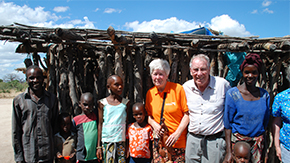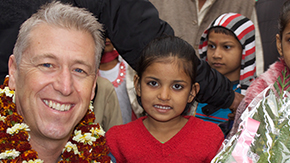It was a huge privilege to see World Vision’s work in practice in central Uganda during a recent visit to meet my sponsored child, Geofrey.
Coming from a farming family in Oxfordshire I was particularly keen to understand what food Geofrey’s family and community eat, how they grow it, and whether they can produce enough to feed their families in a nutritious way. Are they able to produce excess to sell to market and earn cash? Are they still stuck in a cycle of “subsistence farming” – growing only what they need to eat, and barely enough of that?
 Lying on the equator, Uganda really is the “pearl of Africa”, as the tourist information says, and no more so than on the fertile and rolling slopes in rural central Uganda where I recently spent the week with a group of fellow sponsors. With the rich red soils and warm, wet climate you can grow two crops on the same land in one year. For example, maize, beans or potatoes. This is in addition to banana, coffee, avocado or pineapple trees which are growing in abundance, alongside cassava which is another staple crop.
Lying on the equator, Uganda really is the “pearl of Africa”, as the tourist information says, and no more so than on the fertile and rolling slopes in rural central Uganda where I recently spent the week with a group of fellow sponsors. With the rich red soils and warm, wet climate you can grow two crops on the same land in one year. For example, maize, beans or potatoes. This is in addition to banana, coffee, avocado or pineapple trees which are growing in abundance, alongside cassava which is another staple crop.
Farming is a lot of hard work in Uganda, particularly when everything is still done by hand
From digging, planting, weeding and picking, I saw only one tractor working on what looked like a commercial farm and two idle on the roadside. For much of the day it is simply too hot to work.
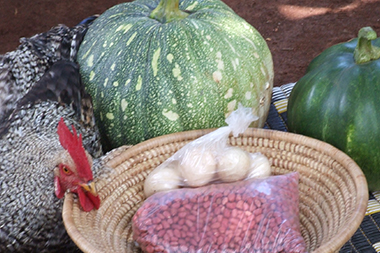 The basic diet in central Uganda can consist of “posho” – ground maize meal turned into a porridge which is often provided to children at school break, matoke (steamed and mashed green banana) and ground nut sauce. Meat – in the form of goat or beef – is a luxury even though families generously gave us some at every meal we ate with them. Plenty of chickens were also running around – their eggs precious protein when hard boiled.
The basic diet in central Uganda can consist of “posho” – ground maize meal turned into a porridge which is often provided to children at school break, matoke (steamed and mashed green banana) and ground nut sauce. Meat – in the form of goat or beef – is a luxury even though families generously gave us some at every meal we ate with them. Plenty of chickens were also running around – their eggs precious protein when hard boiled.
It was good to see that an increasing range of new crops are also being grown: runner beans, cabbage and pumpkins which all add to the nutritional content of their daily meal
It was inspiring meeting and talking to farmers, whether they had a small plot or garden beside their house of 50 x 100 metres as many of the families had, or a relatively large farm of 8 acres, as Charles had, having inherited his parents plot. Charles has been asked by World Vision to use his farm as a demo for neighbours.
Similarly Fred, in another village, is running demo projects within the community. Fred is an inspiring man, experimenting with several relatively large plots of green beans and cabbages which he proudly showed us. For the English veg growers there was not a slug or caterpillar to be seen! Fred, like Charles, is also running a piggery using a new system to develop richer manure for six months, whilst the piglets grow, which can then be used to enrich the soil. Most importantly, so many others are learning from his approach.
 At the other end of the scale we met Brenda, a 14 year old sponsored child, orphaned and living with her Grandmother and younger siblings. She had planted a very small plot of beans and maize by their house, and is responsible for the weeding on Saturdays. She was also looking after the goat World Vision had given her family two years ago. Brenda benefits from selling its offspring (and the idea is to share at least one kid with a neighbour).
At the other end of the scale we met Brenda, a 14 year old sponsored child, orphaned and living with her Grandmother and younger siblings. She had planted a very small plot of beans and maize by their house, and is responsible for the weeding on Saturdays. She was also looking after the goat World Vision had given her family two years ago. Brenda benefits from selling its offspring (and the idea is to share at least one kid with a neighbour).
It was good to see and hear about all these developments which are made possible by sponsors. Also to see the new banana suckers which have been given to some farmer groups direct from the research centre, a range of new bean seeds and the goats given to the most vulnerable families. Clever, another sponsored child, proudly showed us the new cow his family had received from the additional fundraising his sponsor, Gaby, had raised for the community.
We met three different farmer groups, all supported by World Vision. They have formal structures – and many have more women members than men. Some groups meet every Monday morning, and the members are fined if they are late or absent! They learn together about how to improve their farming practices, with some of their group having more agronomy training to share with the others. Many also run carefully managed savings and loans system, to enable them to borrow money from the group. Some groups, such as that led by Immaculate, also make soap to sell.
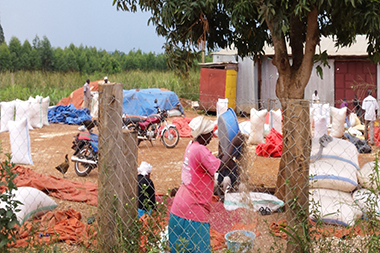 World Vision are also now supporting them to buy better seeds, link them to markets to enable them to sell their produce, including to Kampala, and also supporting the creation of a large co-operative to bring together over sixty smaller farming groups.
World Vision are also now supporting them to buy better seeds, link them to markets to enable them to sell their produce, including to Kampala, and also supporting the creation of a large co-operative to bring together over sixty smaller farming groups.
It was fascinating meeting the farmers and seeing the real progress they are making, with World Vision’s support, improving nutrition by increasing the range of crops grown (and animals), increasing food production and enabling many families to earn cash from extra produce.
The improvements were so visible – and will last long after World Vision has left
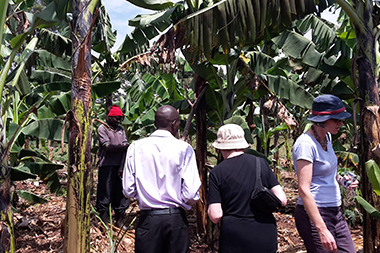 It was also good to share how our farming models were similar but different. I showed several farmers our crops and sheep, and some of the large farm machinery we use. We talked about the weather – a common topic for farmers worldwide – and a real awareness of the potential impact of climate change. It struck me that by their methods of managing the soil, using limited if any pesticides, they are potentially more resilient than we are in the UK.
It was also good to share how our farming models were similar but different. I showed several farmers our crops and sheep, and some of the large farm machinery we use. We talked about the weather – a common topic for farmers worldwide – and a real awareness of the potential impact of climate change. It struck me that by their methods of managing the soil, using limited if any pesticides, they are potentially more resilient than we are in the UK.
Why don't you make the journey to your sponsored child's community to visit them and see more of how your donations are being put to great use. Find out more about visiting your sponsored child »




